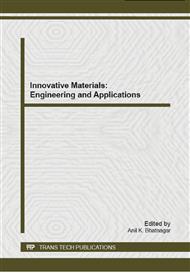[1]
Q.S. Zhang. Industrial utilization of bamboo in China [M]. Beijing: China Forestry Publishing House (1995), pp.39-41.
Google Scholar
[2]
J.M. XU, R.J. Zhao and B.H. Fei. Research on properties and utilization of bamboo in China. Woodworking Machinery, (2007) No. 3.
Google Scholar
[3]
Y.J. Bao. The effects of heat treatment on the physical-mechanical properties of China[J]. Journal of Bamboo Research, Vol. 28, No. 4 (2009).
Google Scholar
[4]
Y.M. Zhang. Discoloration of heat-treated bamboo material[J]. Wood Industry, Vol. 23, No. 5 (2009).
Google Scholar
[5]
Q. Li. Effect of thermo-treatment on physical, mechanical properties and durability of reconstituted bamboo lumber[M]. Beijing: Chinese Academy Of Forestry, (2010).
Google Scholar
[6]
X.Z. Wei. Ultrastructure of cell walls and colour change in phyllostachys pubescens culm after the treatment of ultraviolet irradiation [J], Forest Science, Vol. 39, No. 2 (2009).
Google Scholar
[7]
Q. Li, W.J. Yu. Review of research and development of photo-induced aging of wood [J]. Wood Industry, Vol. 23, No. 4 (2009), pp.33-36.
Google Scholar
[8]
L.Y. Hou, R.J. Zhao and H.Q. Ren. Analysis of surface color and wettability and chemical composition of different age phyllostachys pubescens [J]. Journal of Nanjing Forestry University: Natural Sciences Edition, Vol. 36, No. 2 (2012), pp.159-162.
Google Scholar
[9]
R.Z. Su. The mechanism of light-induced discoloration in surface decoration of wooden materials [M]. China, Northeast Forestry University, (2011).
Google Scholar
[10]
Hon DNS, Chang S T, Feist W C. Participation of singlet oxygen in the photo-degradation of wood surfaces [J]. Wood Science and Technology, Vol. 16, No. 3 (1982), pp.193-201.
DOI: 10.1007/bf00353868
Google Scholar
[11]
Hon DNS, Feist W C. Weathering characteristics of hardwood surfaces[J]. Wood Sci Techno, Vol. 20, No. 2 (1986), p.169.
DOI: 10.1007/bf00351028
Google Scholar
[12]
General Administration of Quality Supervision, Inspection and Quarantine. Standardization Administration of the People's Republic of China. Bamboo physical and mechanical properties test method [S]. Beijing: China Standard Publishing House, (1996).
Google Scholar
[13]
X.Q. Wang. Surface deterioration of moso bamboo (Phyllostachys pubescens) induced by exposure to artificial sunlight[J]. Wood Sci (2009) 55, pp.47-52.
DOI: 10.1007/s10086-008-0994-0
Google Scholar


